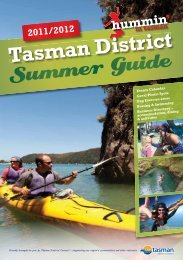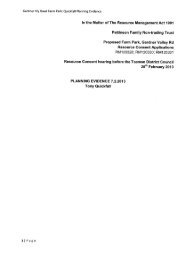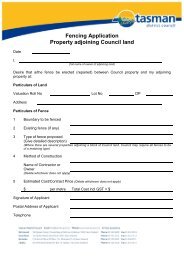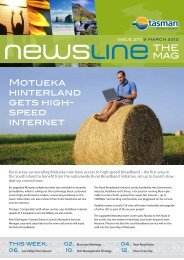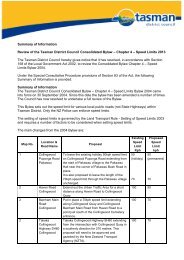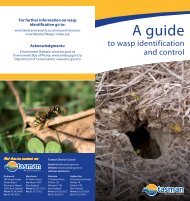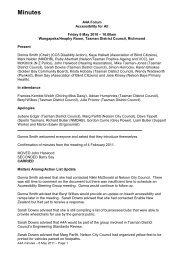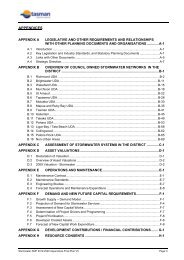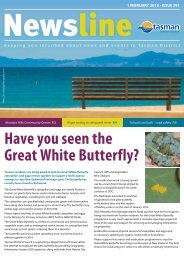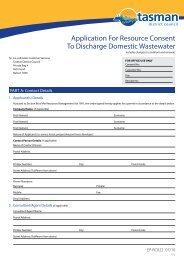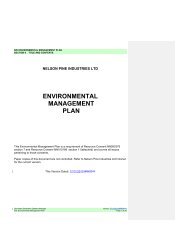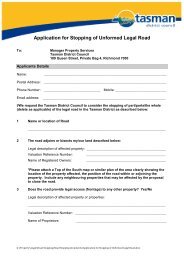RESC11-12-02 Port Motueka Groyne-Jackett Island Erosion ...
RESC11-12-02 Port Motueka Groyne-Jackett Island Erosion ...
RESC11-12-02 Port Motueka Groyne-Jackett Island Erosion ...
Create successful ePaper yourself
Turn your PDF publications into a flip-book with our unique Google optimized e-Paper software.
8<br />
3.7 Training <strong>Groyne</strong>s with nourishment from existing<br />
channel maintenance<br />
This option is an extension of the existing channel maintenance option. In this instance the<br />
placed sediment would be stabilized by the construction of channel training groynes. These<br />
groynes would extend along the seaward edge of <strong>Jackett</strong> <strong>Island</strong> to move the tidal currents away<br />
from the existing shoreline. The issue with these type of structures is that they can transfer<br />
erosion effects down drift as sediment is locked up by the structures. This means that they will<br />
need to extend along the seaward edge of <strong>Jackett</strong> <strong>Island</strong> and most likely extend along Kina<br />
Peninsula. Figure 9 shows an indication of the typical configuration, with 250 m long groynes<br />
along the majority of the <strong>Jackett</strong> <strong>Island</strong> shoreline at 500 m centres, with the length reducing<br />
towards the southern end and Kina to enable a transition to natural shores. We note that these<br />
are indicative only and would need further analysis and testing.<br />
The groynes could be constructed using a similar construction methodology to the existing<br />
training groyne (concrete panels and steel) or from rock armour. Costing of these structures has<br />
been done assuming a rock armour structure 4 m high with 1.5:1 side slopes and a crest width of<br />
2.5 m and a rock armour costing of $90/m 3 based on recent rock revetment works at Ruby Bay.<br />
An additional allowance of 10% of the rock costs has been included for geotextile and associated<br />
works. This equates to a linear metre cost of around $3,350 for a rock groyne. We note<br />
alternative structures may be lower cost, but have used this rate to provide an initial estimate of<br />
costs. The total length of groynes shown on Figure 9 is around 1,680 m.<br />
The costs for these works using a similar allowance for P&G, contingency and engineering and<br />
environmental design as the channel maintenance option results in a cost of around $<strong>12</strong>M for this<br />
option. It is anticipated that ongoing maintenance costs would be low, but may still be in the<br />
order of $50,000 to $100,000 per annum.<br />
There are significant issues that will need to be addressed with this option, including the potential<br />
risks to the down drift (northern) coastline. Extensive studies and assessments would be<br />
required. The structures would also create significant visual impacts and be problematic with<br />
regard to gaining consent.<br />
3.8 Seawall (land protection)<br />
This would be a substantial structure, occupying the existing upper beach extending around the<br />
majority of the island’s perimeter. The structure would have a similar appearance to the seawalls<br />
recently constructed at Ruby Bay. They would create issues of access and visual amenity and may<br />
also result in down drift erosion effects as they would reduce the volume of sand transferred to<br />
the south.<br />
Based on the Ruby Bay seawall rock costs and taking into account the more challenging access<br />
location, a rock revetment would cost in the order of $2,000 to $3,000 per linear metres and<br />
would need to extend along some 2000 m of shoreline. Costs for this option, excluding access<br />
ways, etc would be in the order of $6M to $10M.<br />
There are significant issues that will need to be addressed with this option, including the potential<br />
risks to the down drift (northern) coastline. Extensive studies and assessments would be<br />
required. The structures would also create significant visual impacts and be problematic with<br />
regard to gaining consent.<br />
3.9 Alternative options<br />
It is possible to place sand from another source along the <strong>Jackett</strong> <strong>Island</strong> shoreline. However, this<br />
option does not adequately address the causes of erosion. Without modifying the channel<br />
<strong>Jackett</strong> <strong>Island</strong> Long Term <strong>Erosion</strong> Management Preliminary Practicable Options Report<br />
T&T Ref. 27882-PPO-R2<br />
Tasman District Council November 2011



